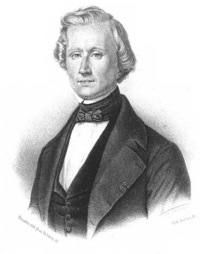Five of the planets in the night sky are easy to see with the unaided eye, and have been known since ancient times. Uranus is just bright enough that you can see it in a perfectly dark place if you know where to look. But Neptune can only be seen in a telescope. And since telescopes have only been around for a few hundred years, Neptune was discovered recently. So, who discovered Neptune?
The mathematician Alexis Bouvard published a series of astronomical tables detailing the orbit of Uranus. Over time, several astronomers realized that there had to be some additional planet deeper out in the Solar System that was influencing the motion of Uranus with its gravity. They set to work calculating where this additional planet might be located in the Solar System.
Two astronomers, Britain’s John Couch Adams and France’s Urbain Le Verrier had worked out the position of the hypothetical 8th planet independently from each other. And both had a difficult time convincing their colleagues to spend any time actually looking where they suggested the planet might be.
The Berlin Observatory astronomer Johann Gottfried Galle used the calculations by Le Verrier to find Neptune within just 1° of its predicted location, and just 12° of Adams’ predictions. Both astronomers claimed that they were the first to discover the planet, and it led to an international dispute.
After the discovery, there was rivalry between England and France about who should get credit for finding Neptune, Adams or Le Verrier. The international astronomy community agreed that the two astronomers should share credit for the discovery. Eventually both Le Verrier and Adams were given credit for discovering Neptune in 1846.
The planet was named after the Roman god of the oceans; the same as the Greek God Poseidon.
Would you like to know how Uranus was discovered?
Of course, this is just a shortened version of the discovery of Neptune. If you’d like to read more, check out this article that talks about the mathematical discovery of planets. And here’s more information on Le Verrier.

